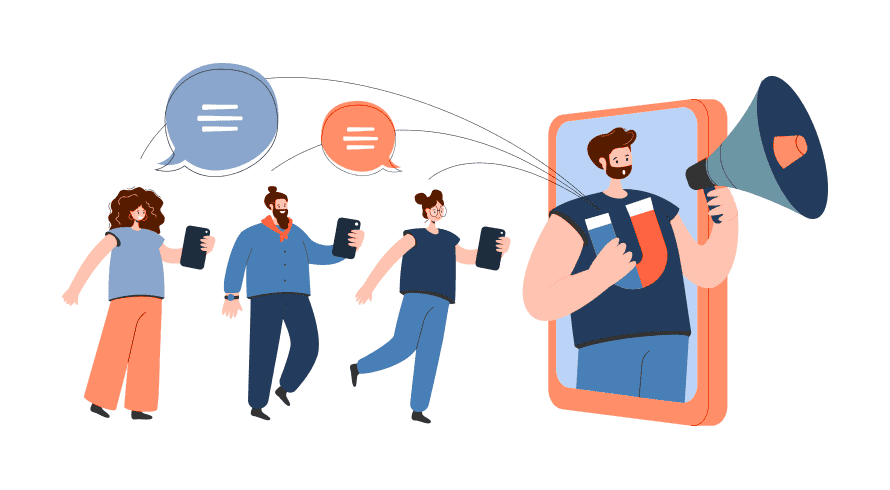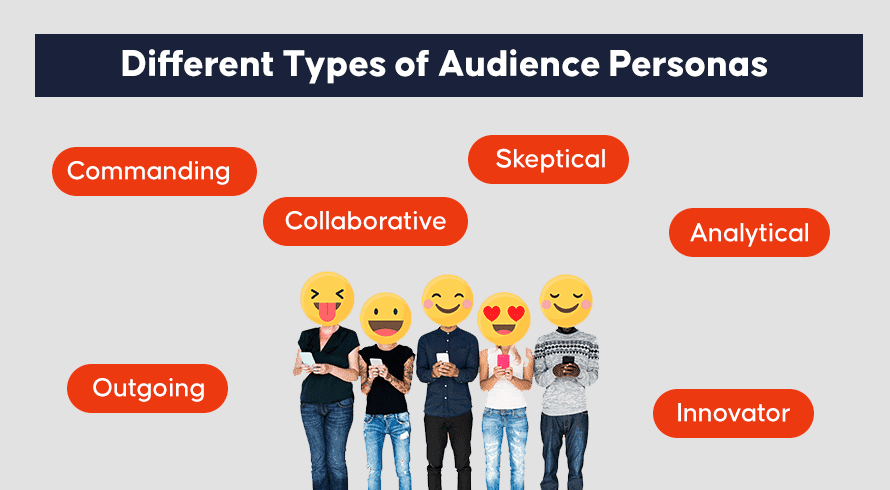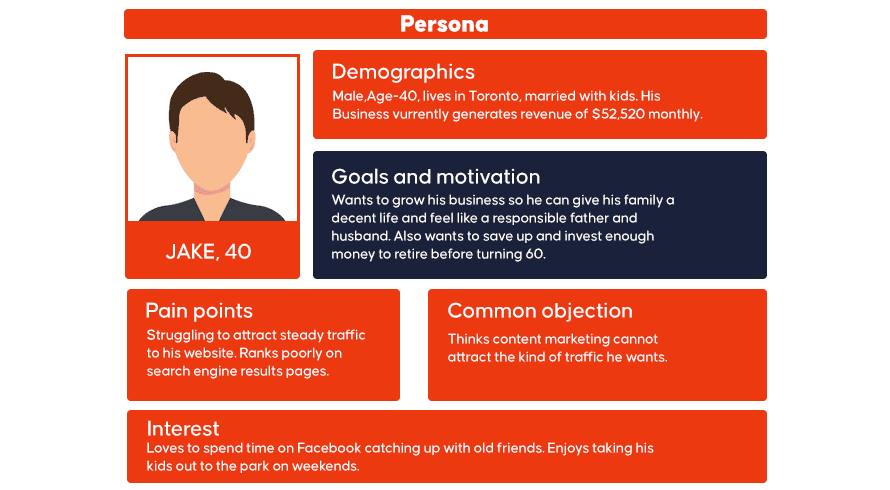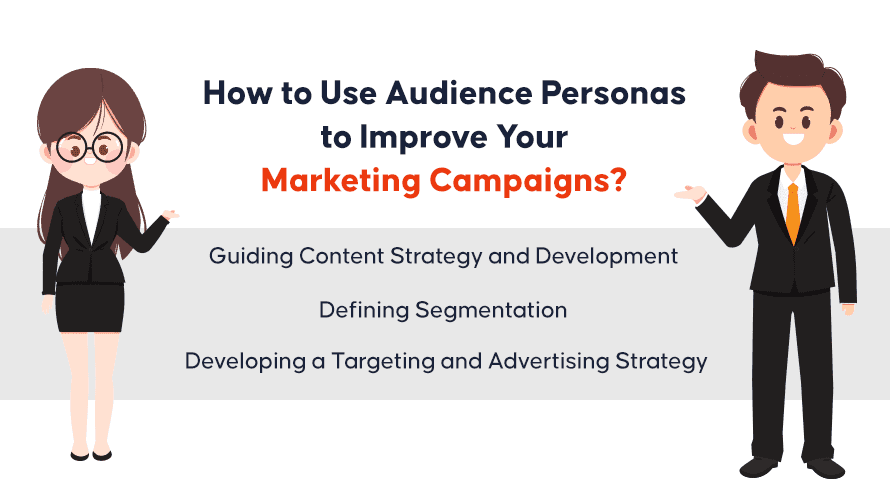Inquivix HQ
1-903, 18 Eonju-ro 146-gil,
Gangnam-gu, Seoul, Korea
06057

Audience personas are the profiles that represent different target audiences for a business, product, or organization. They can be as simple as single-person profiles with background information such as age, skill sets, and interests. They can also be more complex by creating an entire class of people with specific needs and behaviors around a particular topic.
An audience persona, also known as a buyer’s persona creates a comprehensive view of the audience your business needs to reach. It helps us make informed choices about whom to market to and how to speak to them. They improve the quality of user experience by providing insights from real people who might react differently from one another in various situations.
What Is an Audience Persona?
An audience persona represents the people who will be your customers, clients, or recipients of your marketing messages. They also represent the needs and wants of these audiences. They help clarify what you offer for them and how they should feel about your product or service. Target audience personas also help develop a creative campaign by giving you the chance to know their emotions better. They provide a way to understand what problems they typically have and make them happy. They have creative tools that give marketers a way to find out more about their customer base.
The Benefits of an Audience Persona When Running a Campaign

One of the most significant benefits of an Audience Persona is that it helps you create a more targeted marketing campaign. It also allows you to determine which approach would be most suitable for your Audience Persona. They are highly beneficial because they provide you with the information required to adapt your marketing strategy. They are useful when it comes to helping you make decisions on the type of content to produce, how much content should be created, and when it should be released to reach out to your existing customers and target customers in the best way possible.
You can better tailor your campaign to match the needs and wants of your target audience by creating a buyer persona. This will help to improve your chances of success, as your campaign will be more relevant to your target audience. Additionally, the audience persona can help you identify potential customers who may not have been aware of your brand or product.
How Are Buyer Personas Used?
Buyer personas are used to target marketing campaigns to people’s different needs. This is done by identifying common behaviors, desires, and motivations of the target audience persona. It is important to note that not all campaigns can benefit from buyer personas. Therefore, it is essential to know the benefits before running the campaign. Similarly, using buyer personas can help create content and ads that appeal to the target audience. It helps businesses understand their customers to make better content relevant to them. Target audience personas also help companies target their advertising efforts, which can improve the return on investment (ROI).
Different Types of Audience Personas

Commanding
This kind of buyer personas quickly make decisions and take action. They know what they want, and are not afraid to go after it. They’re also good at inspiring others to take action. Once they know what they want, they can make decisions with confidence. This buyer persona is a decision-maker who is sure to stay focused on their goals, and won’t let distractions derail them. Finally, they are not afraid to take risks and go after what they want.
Collaborative
A collaborative buyer persona is more deliberate, tactful, diplomatic, and adaptable. These personas are quite the opposite of commanding personas. They take time to make a decision and ask a lot of questions. So, if your target audience persona is consensus type, make sure that your campaigns cater to their needs.
Outgoing
If your marketing persona is an outgoing and engaging person, you’ll need to focus on networking and building relationships with potential clients. You’ll also need to be active on social media and in online groups where your target audience is likely to be. Feel free to build up a conversation with the outgoing buyer persona types on social media.
Skeptical
This type of person needs objective evidence before they can be convinced or influenced by what you’re pitching them on. These people aren’t typically promoting your product but are fans of the subject. They’re often on forums looking for people to talk about it with. They need more information before they can make up their mind about something, and it’s also hard for them to read into the benefits of the matter you’re trying to sell them. This is especially true when it comes to asking for money.
Analytical
For an analytical buyer persona, data is important. They look at all the information they can gather and analyze them before making a decision. But once they form an opinion, they are ready to stand by it. These kinds of buyer personas are hard to acquire, but once you do they make very loyal customers.
Innovator
The Innovator is the sixth persona in the Audience Persona series. They are easygoing and enjoy being creative. They like to explore new ideas and always look for new ways to improve things. They have a lot of energy and are always looking for new challenges. The Innovator is essential because it can help you develop new ideas for your campaign. They are always looking for ways to improve things so that they can provide valuable feedback on your drive. Plus, their energy and creativity can help keep your campaign exciting.
How to Create an Audience Persona?

Do Thorough Audience Research
It’s time to put your money where your mouth is. Who are the people you already do business with? What is your social audience made up of? Who are your competitors attempting to reach out to? Our comprehensive guide on audience research contains more information.
To hone in on specific information like age, location, language, spending power, and trends, you can use data from your social media analytics (especially Facebook Audience Insights), your consumer database, and Google Analytics. The size of businesses and who makes purchasing decisions are essential factors to consider while developing B2B content.
Identify Customer Pain Points
One of the best ways to identify customer pain points is to ask them directly. You can do this through surveys, interviews, or focus groups. Another way to identify pain points is to look at your website data. This can include data on where people are clicking, how much time they’re spending on each page, and what pages generate the most traffic.
Another approach to learn about your customers is to join forces with your sales staff and customer support staff. However, another essential alternative is social listening and social media sentiment analysis. Setting up search streams to follow mentions of your brand, goods, and competitors provide you with a real-time look at what people are discussing about you online. You might discover why they enjoy your items or which elements of the customer experience need improvement.
Identify Customer Goals
Finding out your customer goal will help set you in the right direction for your campaign. Decide what the individual needs, wants, or desires you can provide. Depending on the items and services you provide, your audience’s objectives might be personal or professional.
- What do your target audience segments want?
- What are their ultimate objectives?
- What are their primary concerns?
- What challenges or difficulties are your potential consumers trying to overcome?
- What is preventing them from achieving their aspirations?
- What hurdles do they encounter in attaining their goals?
Understand How You Can Help
After discovering your consumers’ goals and concerns, it’s time to think about how you might assist them. That necessitates going beneath the surface of your product or service’s features to evaluate its natural benefits. Consider your audience’s major purchasing roadblocks, as well as where they are in their purchase journey.
Create Your Buyer Personas
Gather all of your information and start hunting for recurring traits. Once you connect those qualities, you’ll have a solid basis for your customer personas. Give your buyer persona a name, a job title, address, and any other identifying features. Make sure that your buyer persona appears to be a natural person.
This isn’t just a list of characteristics. This is a comprehensive and detailed description of one possible client in your target audience. It allows you to think about your future customer as a person, rather than numbers, allowing you to consider them as people rather than statistics. These aspects might or may not be included.
How to Use Audience Personas to Improve Your Marketing Campaigns?

Informing Messaging
This is most likely the most frequent reason why marketers establish personas in the first place: so they know what to say to potential customers! Persona creation is essential for conveying key messages and defining your value proposition according to each sort of customer you deal with. You can speak directly to these needs through the content you create if you understand your audience’s needs.
Guiding Content Strategy and Development
Recognizing the needs and wants of your target audience makes it simpler to develop content that they will want to read. Personas can help marketers figure out their burning questions and show you how your ideal audience seeks and consumes information. These factors indicate the subjects you should cover in your material and the format it should take.
Do you want to go a step further? Setting the goal and monitoring content development for each persona becomes much easier once personas have been established. We recommend focusing on one to two personas by producing the necessary content those audiences consume – this may be a live content series, blog articles, or social promotion.
Defining Segmentation
The goal of buyer persona profiles is to develop a clear, visible depiction of your customer by combining the most frequent actions, demographics, and psychographics of your ideal audience. Look for something that sets each persona apart to define your personas. Is it because they work with your company? Is it what drives them to take action?
You may use your marketing personas to create a segmentation plan by defining them and ensuring they are unique. Inbound leads who identify their persona, or, more precisely, infer a lead’s persona based on the material they consume and actions they engage in, should be tracked.
Developing a Targeting and Advertising Strategy
Many marketers, particularly those in the software industry, may collect information on technology use, trusted sources, and research behaviors of their customers when developing personas. People can use these insights to create digital advertising targeting strategies based on demographics and other data.
Conclusion
Audience personas go above and beyond the simple act of checking a box and claiming to have an understanding of our target consumer. They’re a vital tool in each area of your marketing. Creating personas is a significant investment in getting to your client’s core, and it should adapt over time as your business and consumers change.
